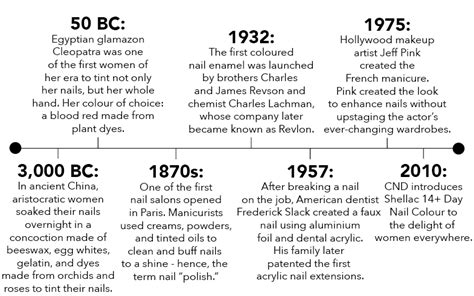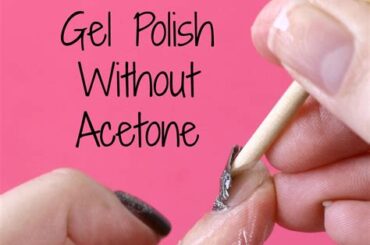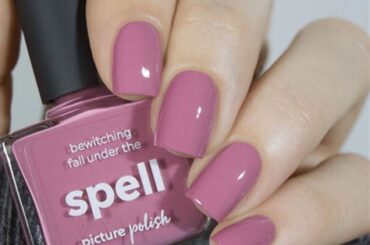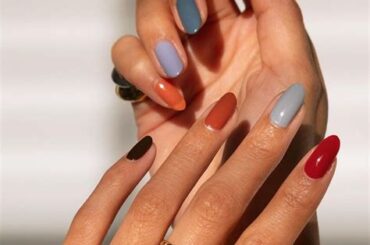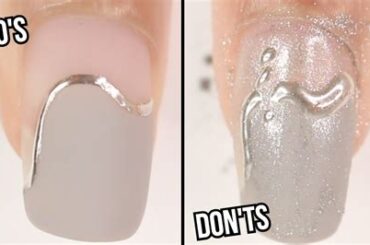Ancient origins of nail adornment
ancient origins of nail adornment
In the ancient world, nail adornment was not just a modern beauty trend, but a symbol of status, wealth, and power. The roots of nail adornment can be traced back to ancient civilizations such as Egypt, Mesopotamia, and China.
In ancient Egypt, elaborate nail designs were worn by both men and women, reflecting their social standing. Pharaohs and royalty would adorn their nails with vibrant colors, using henna and plant-based dyes. Commoners, on the other hand, would opt for more natural shades.
The first recorded use of nail polish
In the fascinating history of nail adornment, the first recorded use of nail polish holds a significant place. Nail polish, also known as nail varnish, is a cosmetic product that is applied to the nails to enhance their appearance and protect them from damage. The use of nail polish dates back thousands of years and has evolved significantly over time.
One of the earliest known instances of nail polish usage can be traced back to ancient China, around 3000 BC. During the Zhou Dynasty, nail polish was predominantly used by higher-ranking individuals, such as royalty and aristocrats. It was a symbol of social status and wealth.
In ancient China, nail polish was made from a combination of beeswax, egg whites, gelatin, gum arabic, and vegetable dyes. These ingredients were carefully mixed together to create vibrant and long-lasting colors. The most popular shades were often red and gold, symbolizing power and luxury.
- The first recorded use of nail polish can be traced back to ancient China.
- Nail polish was a symbol of social status and wealth in ancient China.
- Ancient Chinese nail polish was made from beeswax, egg whites, gelatin, gum arabic, and vegetable dyes.
- Red and gold were the most popular nail polish colors in ancient China, symbolizing power and luxury.
| Ancient Origins of Nail Polish |
|---|
| The first recorded use of nail polish |
| The rise of nail polish in ancient China |
| Nail polish in the Renaissance era |
As time went on, nail polish spread throughout different regions and cultures. In Ancient Egypt, nail polish was also popular among the elite. Both men and women would color their nails using a mixture of beeswax, gum Arabic, and various plant dyes. The shades often varied from deep reds to henna-like colors.
It was not until the early 20th century that modern nail polish as we know it today was introduced. In 1916, a French makeup artist named Michelle Ménard created the first mass-produced, opaque nail polish. This breakthrough was made possible by the use of nitrocellulose, a resin that provided a glossy and hard finish.
From its humble beginnings in ancient China to the revolutionary formulations of the modern era, the use of nail polish has come a long way. Today, nail polish is a staple in the beauty industry, offering a wide range of colors, finishes, and effects. It continues to be an essential accessory for self-expression and fashion.
The rise of nail polish in ancient China
In ancient China, nail polish was not only used as a tool for self-expression but also held significant cultural and social importance. The origins of nail adornment can be traced back to as early as 3000 BCE in ancient China. During the Zhou Dynasty, roughly between 1046 and 256 BC, nail polish was initially made by combining gum arabic, gelatin, beeswax, egg whites, and pigments derived from plants and minerals. The process of creating nail polish became a highly skilled art form, and its popularity soared among the noble classes.
Nail polish in ancient China played a crucial role in indicating the social status of an individual. During the Ming Dynasty, from the 14th to the 17th century, the color of the nail polish denoted a person’s social hierarchy. The higher the rank, the more vibrant and eye-catching the nail polish color became. For instance, the royal family and high-ranking officials were allowed to wear gold or silver nail polish, while lower-ranking citizens were limited to muted shades of red and pink. This strict regulation on nail polish color reflected the hierarchical structure of the society during that time.
Moreover, nail polish in ancient China also served as a visual symbol of marital status. Married women were permitted to wear long and elaborately decorated nails with vibrant nail polish, often showcasing intricate patterns and designs. On the other hand, unmarried women were expected to maintain short and plain nails, signifying their unmarried status. Nail polish became a powerful way for women to express their femininity, beauty, and marital status in ancient Chinese culture.
- Nail polish had various uses in ancient China, ranging from social status indicators to marital symbols.
- The colors of the nail polish during the Ming Dynasty signified the social hierarchy.
- Married women adorned their nails with intricate patterns and designs, while unmarried women had to keep their nails plain and short.
| Time Period | Nail Polish Characteristics |
|---|---|
| Zhou Dynasty (1046 – 256 BC) | Combination of gum arabic, gelatin, beeswax, egg whites, and plant/mineral-based pigments |
| Ming Dynasty (14th – 17th century) | Nail polish colors denoted social hierarchy; married women displayed intricate designs |
Nail polish in the Renaissance era
In the Renaissance era, nail polish was not only a means of enhancing one’s appearance but also a symbol of social status. It was during this time that nail adornment became popular among the upper class in Europe. The use of nail polish began to evolve beyond practical purposes and became a form of self-expression and art.
The first recorded use of nail polish can be traced back to ancient China, where it was believed to have been used as early as 3000 BC. However, it wasn’t until the Renaissance era that nail polish gained widespread popularity in Europe. The wealthy and aristocratic members of society would often paint their nails with vibrant colors to showcase their wealth and social standing.
The rise of nail polish in the Renaissance era can be attributed to the influence of the Italian Renaissance and the desire for luxurious and extravagant lifestyles. Nail polishes were made using various ingredients such as beeswax, egg whites, and flower petals, which were mixed together to create vibrant and long-lasting colors.
- Nail polish in the Renaissance era served as a status symbol for the upper class.
- It was a means of self-expression and art.
- The ingredients used included beeswax, egg whites, and flower petals.
| Advancements in Nail Polish in the Renaissance Era | Impact on Fashion Trends |
|---|---|
| – Nail polish colors became more vibrant and long-lasting. | – Nail polish became a staple in the fashion industry. |
| – New techniques for applying and removing nail polish were developed. | – It influenced the way people accessorized and dressed. |
| – Nail polish containers and applicators became more sophisticated. | – It created new beauty standards and ideals. |
The dawn of modern nail polish formulas
Modern nail polish formulas have revolutionized the way we enhance and beautify our nails. Over the years, nail polish has evolved from simple and basic formulas to more advanced and innovative ones, giving us endless possibilities for creative nail looks. The dawn of modern nail polish formulas marked a turning point in the nail industry, providing not only vibrant colors but also improved durability and long-lasting wear.
One of the groundbreaking developments in modern nail polish formulas was the introduction of nitrocellulose as a key ingredient. This revolutionary compound, derived from plant fibers, played a crucial role in creating a smooth and glossy finish on the nails. Nitrocellulose not only enhanced the appearance of the polish but also improved its adhesion to the nails, ensuring a longer-lasting manicure.
Another significant advancement in modern nail polish formulas was the addition of plasticizers. Plasticizers, such as dibutyl phthalate (DBP), helped to improve the flexibility and durability of the polish. This innovation made the polish less prone to chipping and cracking, providing a more reliable and long-wearing manicure.
The formulation of modern nail polishes also incorporated solvents, which helped in achieving the desired consistency and application properties. Solvents like ethyl acetate and butyl acetate acted as thinners, allowing the polish to spread evenly and smoothly over the nail surface. These solvents evaporated quickly, leaving behind a vibrant and flawless color on the nails.
Furthermore, modern nail polish formulas have been enriched with a wide range of ingredients to cater to different nail needs. Strengthening agents like keratin proteins and calcium were included to promote nail health and prevent brittleness. Vitamin E and other nourishing oils were added to provide moisture and hydration, preventing the nails from becoming dry and brittle.
The advent of modern nail polish formulas has not only transformed the beauty industry but has also become a staple in self-expression and creativity. With a vast array of colors, finishes, and innovative formulas available, individuals can now experiment and showcase their unique style through their manicures. Whether it’s classic reds or bold metallics, modern nail polishes offer endless possibilities for individuals to express their personality and keep up with the latest fashion trends.
- Nitrocellulose
- Plasticizers
- Solvents
- Strengthening agents
- Vitamin E
| Keyword | Description |
|---|---|
| Nitrocellulose | A revolutionary compound derived from plant fibers that provides a smooth and glossy finish to nail polish. |
| Plasticizers | Ingredients like dibutyl phthalate (DBP) that improve the flexibility and durability of nail polish. |
| Solvents | Thinners such as ethyl acetate and butyl acetate that help achieve the desired consistency and application properties of nail polish. |
| Strengthening agents | Ingredients like keratin proteins and calcium that promote nail health and prevent brittleness. |
| Vitamin E | An ingredient added to nail polishes to provide moisture and hydration, preventing the nails from becoming dry and brittle. |
Evolution of nail polish colors and finishes
Over the years, nail polish has become a staple in the beauty industry, allowing individuals to express their creativity and add a pop of color to their nails. The evolution of nail polish colors and finishes has been fascinating, reflecting the changing trends and preferences of society. From the early days of nail adornment to the modern era, let’s explore how nail polish has evolved in terms of colors and finishes.
In the early days of nail adornment, ancient civilizations like the Egyptians and Babylonians used natural substances to color their nails. Henna, a plant-based dye, was often used to create intricate designs on the nails. These early nail adornments were mostly limited to simple colors like red and brown, but they marked the beginning of our fascination with painted nails.
Fast forward to the 1920s, and we witness the first recorded use of nail polish as we know it today. A French makeup artist named Michelle Ménard created the first modern nail polish by mixing powders with pigments and adding them to a viscous substance. This paved the way for a wide variety of colors and finishes, including glitter, metallic, and shimmery options.
- The introduction of bold and vibrant colors in the 1960s revolutionized nail polish trends. The rise of cultural movements like the hippie counterculture and the women’s liberation movement contributed to the popularity of unconventional nail colors. Neon pinks, electric blues, and lime greens became the go-to choices for those looking to make a statement.
- In the 1990s, matte finishes gained significant traction. The non-shiny, velvety texture provided a sophisticated look and added a touch of elegance to the nails. Matte black, in particular, became a popular choice for those seeking a sleek and edgy style.
- With the dawn of the new millennium, nail polish manufacturers started experimenting with unique finishes. Metallic polishes, holographic finishes, and even magnetic designs entered the market, allowing individuals to explore endless possibilities for their nail looks. These innovations breathed new life into the world of nail polish.
In recent years, the nail polish industry has witnessed a surge in nail art trends. From intricate patterns to elaborate designs, nail artists have pushed the boundaries of creativity. 3D nail art, ombré gradients, and negative space designs are just a few examples of the artistic expressions made possible by nail polish.
In conclusion, the evolution of nail polish colors and finishes showcases the ever-changing nature of fashion and self-expression. From the simple nail adornments of ancient civilizations to the bold and vibrant hues of the 1960s, and the innovative finishes of the modern era, nail polish has come a long way. Whether you prefer classic neutrals or daring glittery finishes, there is a nail polish out there to suit every style and personality.
Influence of nail polish on fashion trends
Nail polish has been a part of fashion and self-expression for centuries. It has not only transformed the appearance of nails but has also played a significant role in influencing fashion trends. The use of nail polish has evolved over time, with different colors, finishes, and designs captivating the fashion world. Let’s explore the influence of nail polish on fashion trends and how it has become an essential accessory for individuals seeking to create unique styles.
Throughout history, nail polish has been associated with various fashion movements and cultural shifts. In the ancient origins of nail adornment, people would often use natural pigments and dyes to color their nails. Nail polish was seen as a symbol of status and power, as only the elite had access to these luxurious adornments.
Fast forward to the Renaissance era, and the use of nail polish expanded in popularity. Women would often display intricate designs on their nails, using different shades and patterns. Nail polish became a fashionable accessory that complemented their stylish attires, elevating their overall appearance.
As we entered the modern age, the dawn of nail polish formulas revolutionized the fashion industry. Nail polish became more accessible and affordable for individuals from all walks of life. The first recorded use of nail polish dates back to the early 1900s, where a simple solution of colored powder and ingredients like collodion was used. This newfound accessibility allowed nail polish to become a staple in fashion, contributing to the ever-evolving trends.
- Evolution of nail polish colors and finishes:
- The rise of nail polish in ancient China:
- Influence of nail polish on fashion trends:
The evolution of nail polish colors and finishes played a significant role in shaping fashion trends. From the classic red and pink hues to vibrant and unconventional colors, nail polish became a means of self-expression. Individuals could choose nail polish shades that reflected their moods, personalities, and overall style. The introduction of different finishes, such as matte, metallic, and holographic, allowed for even more creativity in nail artistry.
Ancient China holds the honor of the first recorded use of nail polish. During the Zhou Dynasty, nail polish was created using a combination of beeswax, egg white, and gum arabic. The colors used represented social class, with lower classes restricted to pale colors. The rise of nail polish in ancient China not only influenced fashion but also provided insight into social hierarchies of the time.
Influence of nail polish on fashion trends cannot be understated. Nail polish has the power to transform an entire look. It completes an outfit, enhances confidence, and adds a final touch of glamour. Fashion designers often incorporate nail polish into their runway shows, with models showcasing the latest nail art trends. Nail polish has become a vital accessory, allowing individuals to experiment with different colors, designs, and lengths, contributing to the ever-changing fashion landscape.
Frequently Asked Questions
1. What are the ancient origins of nail adornment?
Ancient civilizations such as Egypt, Babylon, and India used henna and other natural dyes to decorate their nails as early as 3000 BCE.
2. When was the first recorded use of nail polish?
The first recorded use of nail polish can be traced back to Ancient China around 3000 BCE. The Chinese used a mixture of beeswax, gum arabic, and colored powder to create nail polish.
3. How did nail polish rise in popularity in ancient China?
Nail polish became highly popular among royalty and aristocrats in ancient China. They used various colors to denote social status and to enhance their beauty.
4. Did nail polish have a significant presence in the Renaissance era?
Yes, nail polish was still used in the Renaissance era. However, it was considered more fashionable to have natural-looking nails, so nail polish was often used sparingly or in pale colors.
5. When did modern nail polish formulas start to emerge?
The dawn of modern nail polish formulas can be traced back to the early 20th century. In the 1920s, a French makeup artist named Michelle Menard created the first nail polish using tinted nail lacquer.
6. How have nail polish colors and finishes evolved over time?
Nail polish colors and finishes have evolved significantly over time. From the classic reds and pinks to a wide range of shades and finishes like metallics, glitters, and holographics, there is now a vast array of options available in the market.
7. How has nail polish influenced fashion trends?
Nail polish has had a substantial influence on fashion trends. It has become a form of self-expression and an extension of personal style. Nail art, intricate designs, and unique nail polish combinations have become popular ways to make a fashion statement.

